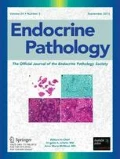Abstract
Hyperplastic changes of the neuroendocrine cell system may have the potential to evolve into neoplastic diseases. This is particularly the case in the setting of genetically determined and hereditary neuroendocrine tumor syndromes such as MEN1. The review discusses the MEN1-associated hyperplasia–neoplasia sequence in the development of gastrinomas in the duodenum and glucagon-producing tumors in the pancreas. It also presents other newly described diseases (e.g., glucagon cell adenomatosis and insulinomatosis) in which the tumors are (or most likely) also preceded by islet cell hyperplasia. Finally, the pseudohyperplasia of PP-rich islets in the pancreatic head is defined as a physiologic condition clearly differing from other hyperplastic–neoplastic neuroendocrine diseases.




Similar content being viewed by others
References
Anlauf M, Garbrecht N, Henopp T et al. Sporadic versus hereditary gastrinomas of the duodenum and pancreas: distinct clinico-pathological and epidemiological features. World J. Gastroenterol. 12: 5440-5446, 2006.
Kloppel G Classification and pathology of gastroenteropancreatic neuroendocrine neoplasms. Endocrine-related cancer 18 Suppl 1: S1-16, 2011.
Capella C, Riva C, Rindi G et al. Histopathology, hormone products, and clinicopathological profile of endocrine tumors of the upper small intestine: a study of 44 cases. Endocr. Pathol. 2: 92-110, 1991.
Anlauf M, Enosawa T, Henopp T et al. Primary lymph node gastrinoma or occult duodenal microgastrinoma with lymph node metastases in a MEN1 patient: the need for a systematic search for the primary tumor. American Journal of Surgical Pathology 32: 1101-1105, 2008.
Anlauf M, Perren A, Henopp T et al. Allelic deletion of the MEN1 gene in duodenal gastrin and somatostatin cell neoplasms and their precursor lesions. Gut 56: 637-644, 2007.
Merchant SH, VanderJagt T, Lathrop S, Amin MB Sporadic duodenal bulb gastrin-cell tumors: association with Helicobacter pylori gastritis and long-term use of proton pump inhibitors. American Journal of Surgical Pathology 30: 1581-1587, 2006.
Anlauf M, Schlenger R, Perren A et al. Microadenomatosis of the endocrine pancreas in patients with and without the multiple endocrine neoplasia type 1 syndrome. American Journal of Surgical Pathology 30: 560-574, 2006.
Perren A, Anlauf M, Henopp T et al. Multiple endocrine neoplasia type 1: loss of one MEN1 allele in tumors and monohormonal endocrine cell clusters, but not in islet hyperplasia of the pancreas. A combined FISH and immunofluorescence study. J. Clin. Endocrinol. Metab. 92: 1118-1128, 2007.
Henopp T, Anlauf M, Schmitt A et al. Glucagon cell adenomatosis: a newly recognized disease of the endocrine pancreas. The Journal of clinical endocrinology and metabolism 94: 213-217, 2009.
Zhou C, Dhall D, Nissen NN, Chen CR, Yu R Homozygous P86S mutation of the human glucagon receptor is associated with hyperglucagonemia, alpha cell hyperplasia, and islet cell tumor. Pancreas 38: 941-946, 2009.
Yu R, Dhall D, Nissen NN, Zhou C, Ren SG Pancreatic neuroendocrine tumors in glucagon receptor-deficient mice. PloS one 6: e23397, 2011.
Yu R Pancreatic alpha-Cell Hyperplasia: Facts and Myths. The Journal of clinical endocrinology and metabolism: jc20132952, 2013.
Anlauf M, Bauersfeld J, Raffel A et al. Insulinomatosis. A multicentric insulinoma disease that frequently causes early recurrent hyperinsulinemic hypoglycemia. American Journal of Surgical Pathology 33: 339-346, 2009.
Perigny M, Hammel P, Corcos O et al. Pancreatic endocrine microadenomatosis in patients with von Hippel-Lindau disease: characterization by VHL/HIF pathway proteins expression. The American journal of surgical pathology 33: 739-748, 2009.
Malaisse-Lagae F, Stefan Y, Cox J, Perrelet A, Orci L Identification of a lobe in the adult human pancreas rich in pancreatic polypeptide. Diabetologia 17: 361-365, 1979.
Bommer G, Friedel U, Heitz PU, Klöppel G Pancreatic PP cell distribution and hyperplasia: Immunocytochemical morphology in normal pancreas, chronic pancreatitis and pancreatic carcinoma. Virchows Archiv [A] Pathologische Anatomie 387: 319-331, 1980.
Ouyang D, Dhall D, Yu R Pathologic pancreatic endocrine cell hyperplasia. World journal of gastroenterology : WJG 17: 137-143, 2011.
Lohr M, Kloppel G Residual insulin positivity and pancreatic atrophy in relation to duration of chronic type 1 (insulin-dependent) diabetes mellitus and microangiopathy. Diabetologia 30: 757-762, 1987.
Albers MB et al., Pancreatic polypeptide rich islets in the posterior portion of the pancreatic head—a tumor mimic in somatostatin receptor scintigraphy. The Pancreas 2013 (in press).
Author information
Authors and Affiliations
Corresponding author
Rights and permissions
About this article
Cite this article
Klöppel, G., Anlauf, M., Perren, A. et al. Hyperplasia to Neoplasia Sequence of Duodenal and Pancreatic Neuroendocrine Diseases and Pseudohyperplasia of the PP-cells in the Pancreas. Endocr Pathol 25, 181–185 (2014). https://doi.org/10.1007/s12022-014-9317-8
Published:
Issue Date:
DOI: https://doi.org/10.1007/s12022-014-9317-8




